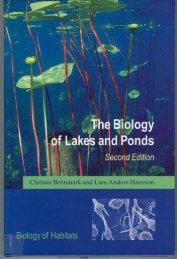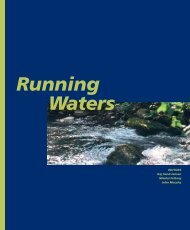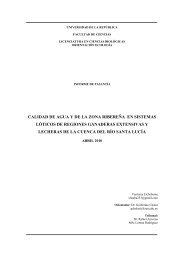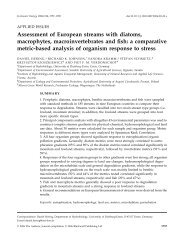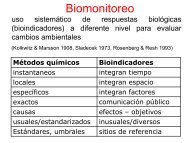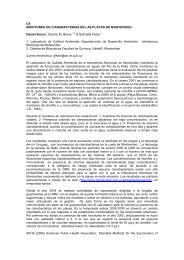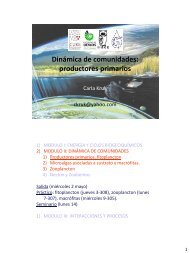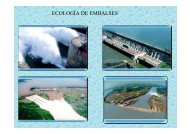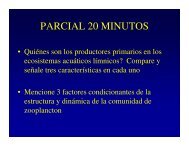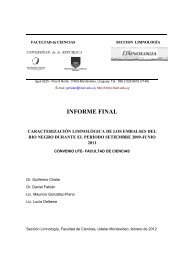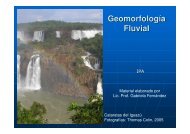info - Sección Limnología - Facultad de Ciencias
info - Sección Limnología - Facultad de Ciencias
info - Sección Limnología - Facultad de Ciencias
Create successful ePaper yourself
Turn your PDF publications into a flip-book with our unique Google optimized e-Paper software.
BIOVOLUMEN (um-3.l-1)<br />
1.4e+9 cola<br />
1.2e+9<br />
1.0e+9<br />
8.0e+8<br />
6.0e+8<br />
4.0e+8<br />
2.0e+8<br />
0.0<br />
3e+9<br />
3e+9<br />
2e+9<br />
2e+9<br />
1e+9<br />
5e+8<br />
0<br />
2.5e+9<br />
2.0e+9<br />
1.5e+9<br />
1.0e+9<br />
5.0e+8<br />
0.0<br />
Bzo Feliciana<br />
Bzo Pedrera<br />
Bzo Sauce<br />
Bzo Izquierdo Centro<br />
oct.09<br />
dic.09<br />
ene.10<br />
feb.10<br />
mar.10<br />
jul.10<br />
oct.10<br />
MESES<br />
dic.10<br />
Ene.11<br />
Feb.11<br />
Mar.11<br />
oct.09<br />
dic.09<br />
ene.10<br />
feb.10<br />
mar.10<br />
jul.10<br />
oct.10<br />
MESES<br />
dic.10<br />
Ene.11<br />
Feb.11<br />
Mar.11<br />
1.2e+9<br />
1.0e+9<br />
8.0e+8<br />
6.0e+8<br />
4.0e+8<br />
2.0e+8<br />
0.0<br />
2.5e+9<br />
2.0e+9<br />
1.5e+9<br />
1.0e+9<br />
5.0e+8<br />
0.0<br />
3.5e+9<br />
3.0e+9<br />
2.5e+9<br />
2.0e+9<br />
1.5e+9<br />
1.0e+9<br />
5.0e+8<br />
0.0<br />
BIOMASA TOTAL<br />
BIOMASA CLADOCERA<br />
BIOMASA COPEPODA<br />
BIOMASA ROTIFERA<br />
BIOMASA MOLUSCA<br />
Figura 24. Biomasa total y <strong>de</strong> los principales grupos <strong>de</strong>l zooplancton expresada como biovolumen (μm -3 .L -1 ).<br />
DISCUSIÓN<br />
Las condiciones físico-químicas encontradas en el embalse <strong>de</strong> Paso Severino durante<br />
el período analizado se encuentran <strong>de</strong>ntro <strong>de</strong> los rangos reportados para estos sistemas en<br />
Uruguay (Chalar et al ., 1993; 2002; 2010; 2012, Con<strong>de</strong> et al., 2002 entre otros). Este embalse<br />
mantiene elevadas concentraciones <strong>de</strong> nutrientes (nitrógeno y fósforo) en forma inorgánica,<br />
indicando una alta biodisponibilidad <strong>de</strong> estos elementos. El embalse Paso Severino muestra<br />
concentraciones <strong>de</strong> fósforo total y ortofosfato superiores a la <strong>de</strong> los embalses <strong>de</strong> Canelón<br />
Gran<strong>de</strong> (Arocena et al., 2010 ), Salto Gran<strong>de</strong> (Chalar et al., 1993, 2002 ) y Río Negro (Chalar<br />
et al., 2012). La concentración <strong>de</strong> Nitrógeno total fue similar a la <strong>de</strong>l embalse Canelón Gran<strong>de</strong><br />
(Arocena et al 2010). En cambio los valores <strong>de</strong> amonio registrados fueron notoriamente<br />
superiores en el embalse <strong>de</strong> Paso Severino (Arocena et al. 2010).<br />
En base a la clasificación trófica <strong>de</strong> límites fijos propuesta por la OCDE (1982) y<br />
según las categorías tróficas <strong>de</strong> Salas y Martino (1990) el embalse <strong>de</strong> Paso Severino por la<br />
77<br />
BIOVOLUMEN (um-3.l-1)



